Optimization Design of Mix Proportion for Fly Ash–Silica Fume–Basalt Fiber–Polypropylene Fiber Concrete under Steam Curing Condition
Abstract
:1. Introduction
2. Experimental Materials and Methods
2.1. Materials
2.2. Design of Orthogonal Experiment
2.3. Sample Preparation and Mechanical Test
2.4. Nuclear Magnetic Resonance (NMR) Test
2.5. Scanning Electron Microscope (SEM) Test
3. Orthogonal Experimental Results Analysis
3.1. Compressive Strength
3.2. Splitting Tensile Strength
4. Determination of Optimal Mix Proportion
4.1. Macroscopic Mechanical Performances
4.2. Pore Characteristics
4.3. Microstructure
5. Conclusions
- (1)
- Range and variance analyses reveal the sequence of impact of four components (FA, SF, BF, and PF) on the 28d compressive strength of steam-cured concrete as SF > BF > FA > PF. Moreover, the sequence of their effect on the 28d splitting tensile strength of steam-cured concrete is determined as BF > PF > SF > FA.
- (2)
- Optimal performance in FA-SF-BF-PF steam-cured concrete is attained with the constituent ratios of 15 wt% for FA, 10 wt% for SF, 0.2 vol% for BF, and 0.1 vol% for PF.
- (3)
- Upon incorporating the optimal proportions of FA, SF, BF, and PF into steam-cured concrete, the 28d compressive and splitting tensile strengths of the concrete demonstrate respective enhancements of 28% and 40% in comparison to conventional concrete.
- (4)
- Autoclaved concrete has the best pore characteristics and densest microstructure using the optimal blend of fly ash, silica fume, basalt fiber, and polypropylene fiber, resulting in a 47.2% reduction in porosity compared to normal concrete.
Author Contributions
Funding
Institutional Review Board Statement
Informed Consent Statement
Data Availability Statement
Conflicts of Interest
References
- Forcael, E.; Ferrari, I.; Opazo-Vega, A.; Pulido-Arcas, J.A. Construction 4.0: A Literature Review. Sustainability 2020, 12, 9755. [Google Scholar] [CrossRef]
- Zeyad, A.M.; Johari, M.A.M.; Alharbi, Y.R.; Abadel, A.A.; Amran, Y.H.M.; Tayeh, B.A.; Abutaleb, A. Influence of steam curing regimes on the properties of ultrafine POFA-based high-strength green concrete. J. Build. Eng. 2021, 38, 775–784. [Google Scholar] [CrossRef]
- Sammak, M.; Mousavinejad, S.H.G. An experimental study on the effect of thickness and connection type of precast ultra-high-performance fiber-reinforced geopolymer concrete plates on the load–deflection capacity of one-way concrete slabs. Structures 2023, 58, 105462. [Google Scholar] [CrossRef]
- Liu, L.; He, Z.; Cai, X.; Fu, S. Application of Low-Field NMR to the Pore Structure of Concrete. Appl. Magn. Reson. 2020, 52, 15–31. [Google Scholar] [CrossRef]
- El-Naqeeb, M.H.; Hassanli, R.; Zhuge, Y.; Ma, X.; Manalo, A. Numerical investigation on the behaviour of socket connections in GFRP-reinforced precast concrete. Eng. Struct. 2024, 303, 117489. [Google Scholar] [CrossRef]
- Gonzalez-Corominas, A.; Etxeberria, M.; Poon, C.S. Influence of steam curing on the pore structures and mechanical properties of fly-ash high performance concrete prepared with recycled aggregates. Cem. Concr. Compos. 2016, 71, 77–84. [Google Scholar] [CrossRef]
- Benli, A.; Karataş, M.; Bakir, Y. An experimental study of different curing regimes on the mechanical properties and sorptivity of self-compacting mortars with fly ash and silica fume. Constr. Build. Mater. 2017, 144, 552–562. [Google Scholar] [CrossRef]
- Shi, J.; Liu, B.; Zhou, F.; Shen, S.; Guo, A.; Xie, Y. Effect of steam curing regimes on temperature and humidity gradient, permeability and microstructure of concrete. Constr. Build. Mater. 2021, 281, 122562. [Google Scholar] [CrossRef]
- Shi, J.; Liu, B.; Zhou, F.; Shen, S.; Dai, J.; Ji, R.; Tan, J. Heat damage of concrete surfaces under steam curing and improvement measures. Constr. Build. Mater. 2020, 252, 119104. [Google Scholar] [CrossRef]
- Ma, K.; He, J.; Long, G.; Dang, H.; Xie, Y. Steam-curing temperature effect and its influence on heat damage of cement-based materials. Mater. Rev. 2017, 31, 171–176. [Google Scholar] [CrossRef]
- Tran, V.M.; Nguyen, L.T.; Nguyen, T.H.Y. Enhancing the effectiveness of steam curing for cement paste incorporating fly ash based on long-term compressive strength and reaction degree of fly ash. Case Stud. Constr. Mater. 2022, 16, e01146. [Google Scholar] [CrossRef]
- Zeyad, A.M.; Azmi Megat Johari, M.; Abutaleb, A.; Tayeh, B.A. The effect of steam curing regimes on the chloride resistance and pore size of high–strength green concrete. Constr. Build. Mater. 2021, 280, 122409. [Google Scholar] [CrossRef]
- Moser, R.D.; Singh, P.M.; Kahn, L.F.; Kurtis, K.E. Chloride-induced corrosion resistance of high-strength stainless steels in simulated alkaline and carbonated concrete pore solutions. Corros. Sci. 2012, 57, 241–253. [Google Scholar] [CrossRef]
- Sadrmomtazi, A.; Tahmouresi, B.; Kohani Khoshkbijari, R. Effect of fly ash and silica fume on transition zone, pore structure and permeability of concrete. Mag. Concr. Res. 2018, 70, 519–532. [Google Scholar] [CrossRef]
- Ramezanianpour, A.M.; Esmaeili, K.; Ghahari, S.A.; Ramezanianpour, A.A. Influence of initial steam curing and different types of mineral additives on mechanical and durability properties of self-compacting concrete. Constr. Build. Mater. 2014, 73, 187–194. [Google Scholar] [CrossRef]
- Aqel, M.; Panesar, D.K. Hydration kinetics and compressive strength of steam-cured cement pastes and mortars containing limestone filler. Constr. Build. Mater. 2016, 113, 359–368. [Google Scholar] [CrossRef]
- Ramezani, M.; Dehghani, A.; Sherif, M.M. Carbon nanotube reinforced cementitious composites: A comprehensive review. Constr. Build. Mater. 2022, 315, 125100. [Google Scholar] [CrossRef]
- Yang, L.; Xie, H.; Zhang, D.; Zhang, F.; Lin, C.; Fang, S. Acoustic emission characteristics and crack resistance of basalt fiber reinforced concrete under tensile load. Constr. Build. Mater. 2021, 312, 125442. [Google Scholar] [CrossRef]
- Wang, D.; Ju, Y.; Shen, H.; Xu, L. Mechanical properties of high performance concrete reinforced with basalt fiber and polypropylene fiber. Constr. Build. Mater. 2019, 197, 464–473. [Google Scholar] [CrossRef]
- Liang, N.; Mao, J.; Yan, R.; Liu, X.; Zhou, X. Corrosion resistance of multiscale polypropylene fiber-reinforced concrete under sulfate attack. Case Stud. Constr. Mater. 2022, 16, e01065. [Google Scholar] [CrossRef]
- Li, Y.; Zhang, Y.-G.; Liu, W.; Yan, Z.-H.; Gu, Z.-C. Effect of ultra-low temperature freeze-thaw cycle on the flexural performance of hybrid fiber RC beams subjected to monotonic and repeated loading. Structures 2024, 59, 105751. [Google Scholar] [CrossRef]
- Sabarish, K.V.; Parvati, T.S. An experimental investigation on L9 orthogonal array with various concrete materials. In Proceedings of the International Conference on Newer Trends and Innovations in Mechanical Engineering (ICONTIME)—Materials Science, Electronic Network, 15–16 October 2021; pp. 3045–3050. [Google Scholar]
- GB/T 50081-2019; Standard for Test Methods of Long-Term Performance and Durability of Ordinary Concrete. Chinese National Standardization Administration (GB): Beijing, China; Standards Press of China: Beijing, China, 2019.
- GB/T 50107-2010; Standard for Test and Evaluation of Concrete Strength. Chinese National Standardization Administration (GB): Beijing, China; Standards Press of China: Beijing, China, 2010.
- JGJ/T 221-2010; Technical Specification for Application of Fiber Reinforced Concrete. Chinese National Standardization Administration (GB): Beijing, China; China Construction Industry Press: Beijing, China, 2010.
- Ghosh, R.; Lahoti, M.; Shah, B. A succinct review on the use of NMR spectroscopy in monitoring hydration, strength development, and inspection of concrete. In Proceedings of the Conference on Environment Concerns and Its Remediation—Materials Science (F-EIR), Chandigarh, India, 18–22 October 2021; pp. 167–173. [Google Scholar]
- Feng, J.; Yin, G.; Tuo, H.; Niu, Z. Parameter optimization and regression analysis for multi-index of hybrid fiber-reinforced recycled coarse aggregate concrete using orthogonal experimental design. Constr. Build. Mater. 2021, 267, 121013. [Google Scholar] [CrossRef]
- Alamri, M.; Ali, T.; Ahmed, H.; Qureshi, M.Z.; Elmagarhe, A.; Adil Khan, M.; Ajwad, A.; Sarmad Mahmood, M. Enhancing the engineering characteristics of sustainable recycled aggregate concrete using fly ash, metakaolin and silica fume. Heliyon 2024, 10, e29014. [Google Scholar] [CrossRef]
- Al-Rousan, E.T.; Khalid, H.R.; Rahman, M.K. Fresh, mechanical, and durability properties of basalt fiber-reinforced concrete (BFRC): A review. Dev. Built Environ. 2023, 14, 100155. [Google Scholar] [CrossRef]
- Ramezani, M.; Kim, Y.H.; Sun, Z. Mechanical properties of carbon-nanotube-reinforced cementitious materials: Database and statistical analysis. Mag. Concr. Res. 2020, 72, 1047–1071. [Google Scholar] [CrossRef]
- Ramezani, M.; Kim, Y.H.; Sun, Z.; Sherif, M.M. Influence of carbon nanotubes on properties of cement mortars subjected to alkali-silica reaction. Cem. Concr. Compos. 2022, 131, 104596. [Google Scholar] [CrossRef]
- Warsi, S.B.F.; Panda, B.; Biswas, P. Exploring fibre addition methods and mechanical properties of fibre-reinforced 3D printed concrete: A review. Dev. Built Environ. 2023, 16, 100295. [Google Scholar] [CrossRef]
- Wu, Z. High Performance Concrete; China Railway Publishing House: Beijing, China, 1999. [Google Scholar]
- Afroz, M.; Venkatesan, S.; Patnaikuni, I. Effects of hybrid fibers on the development of high volume fly ash cement composite. Constr. Build. Mater. 2019, 215, 984–997. [Google Scholar] [CrossRef]
- Nazeer, M.; Kapoor, K.; Singh, S.P. Strength, durability and microstructural investigations on pervious concrete made with fly ash and silica fume as supplementary cementitious materials. J. Build. Eng. 2023, 69, 106275. [Google Scholar] [CrossRef]
- Ren, J.; Luo, X.; Bai, R.; Pan, C.; Zhang, J. Pore characteristics of different phase in nano-modified concrete and their influences on the compressive strength. J. Build. Eng. 2022, 46, 103784. [Google Scholar] [CrossRef]
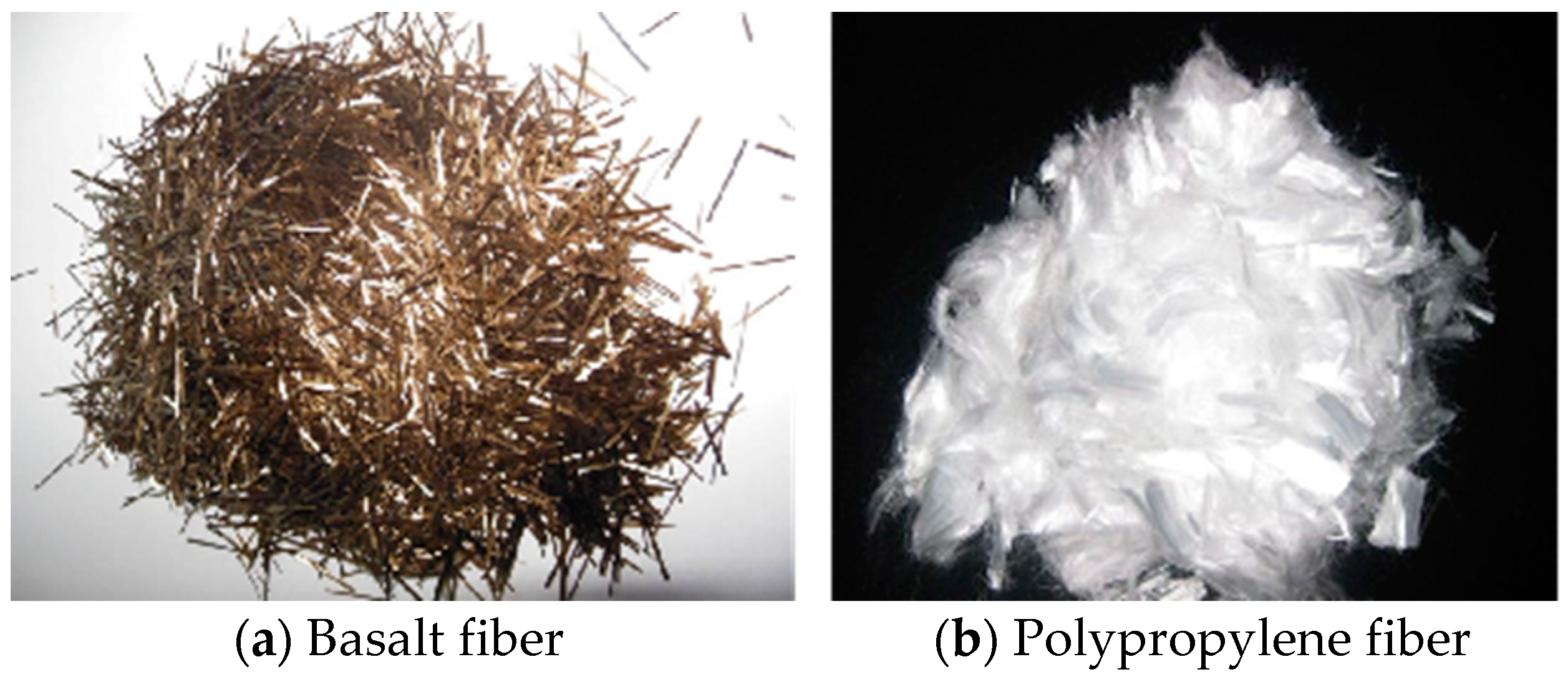


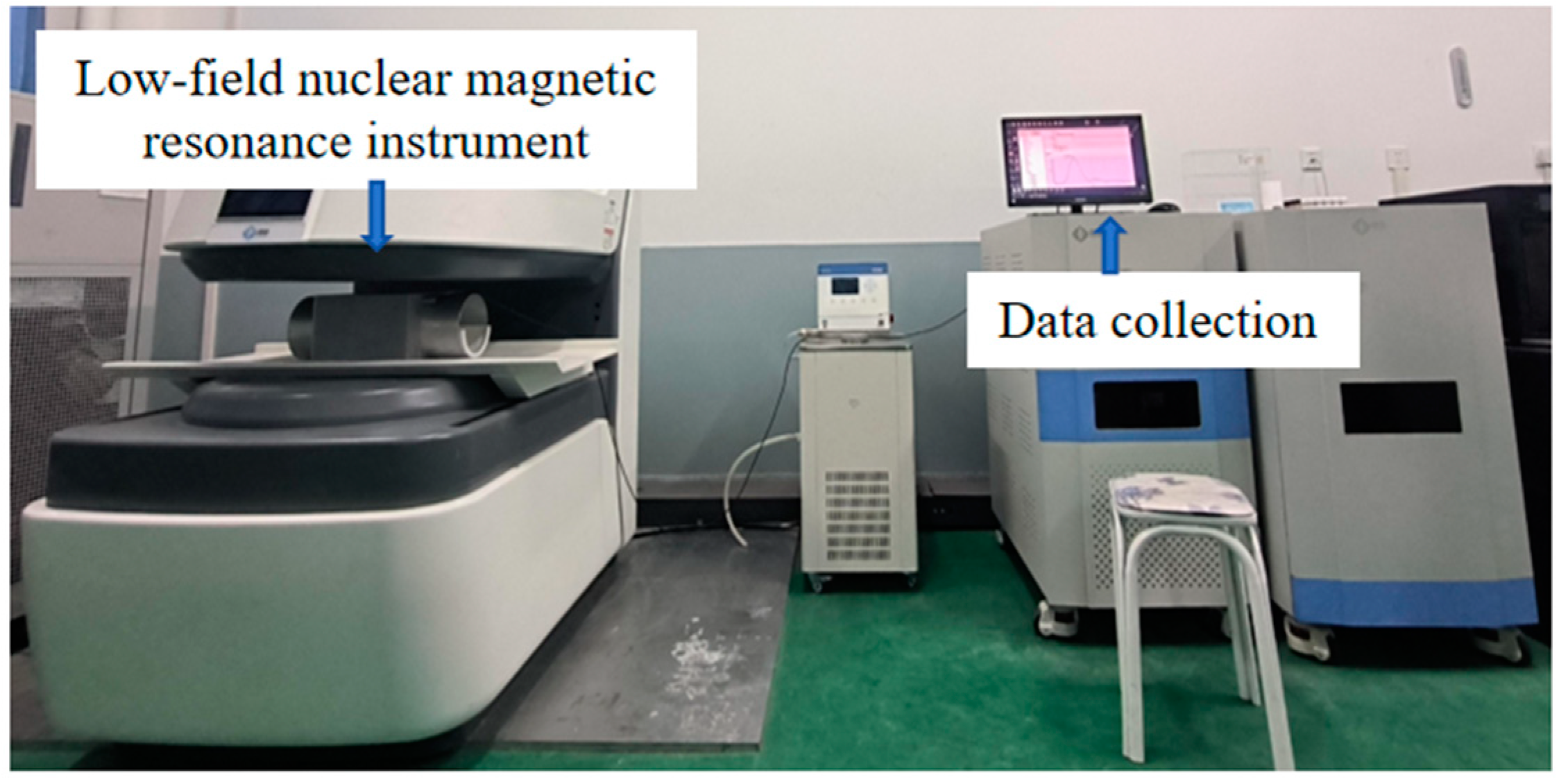
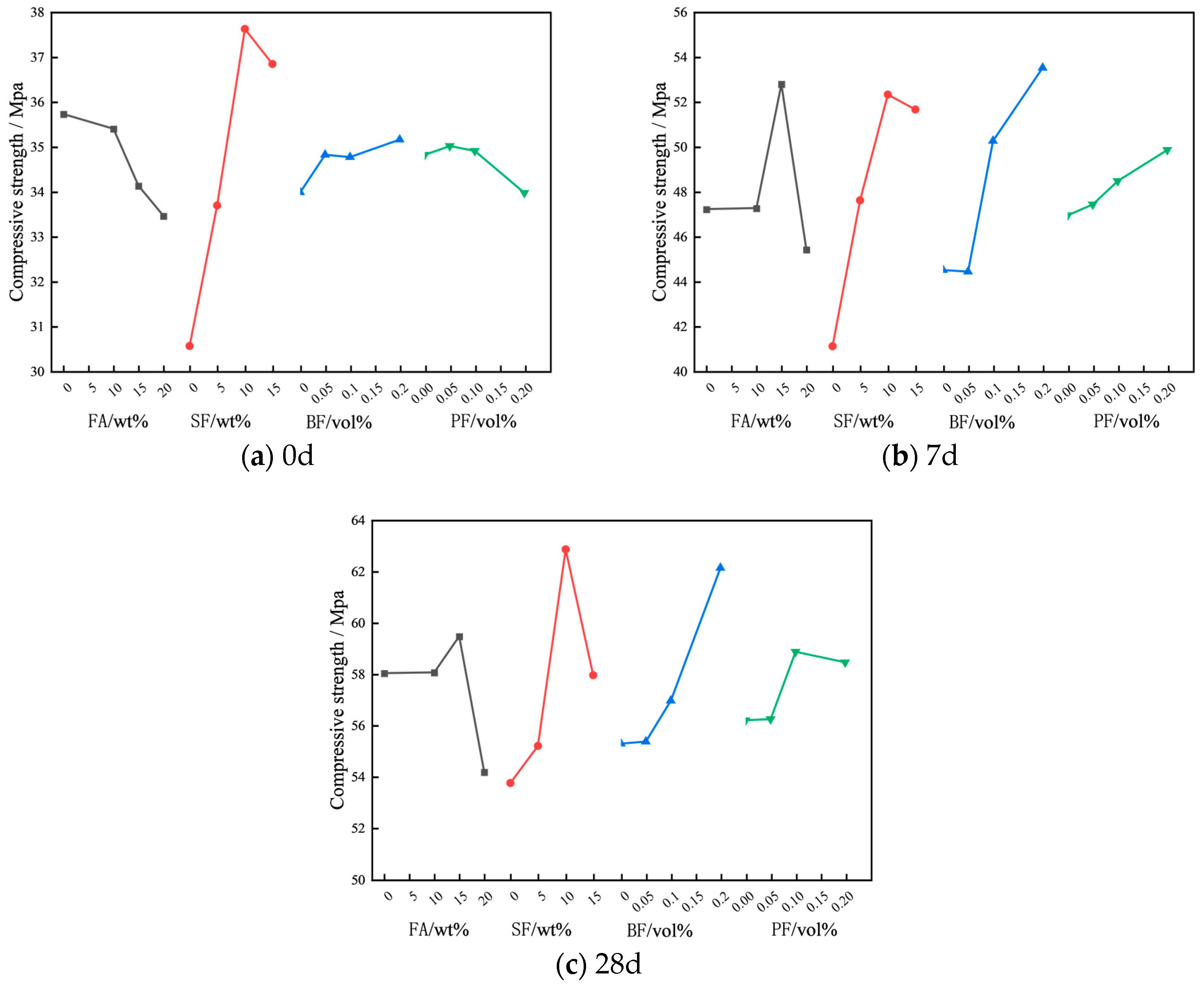

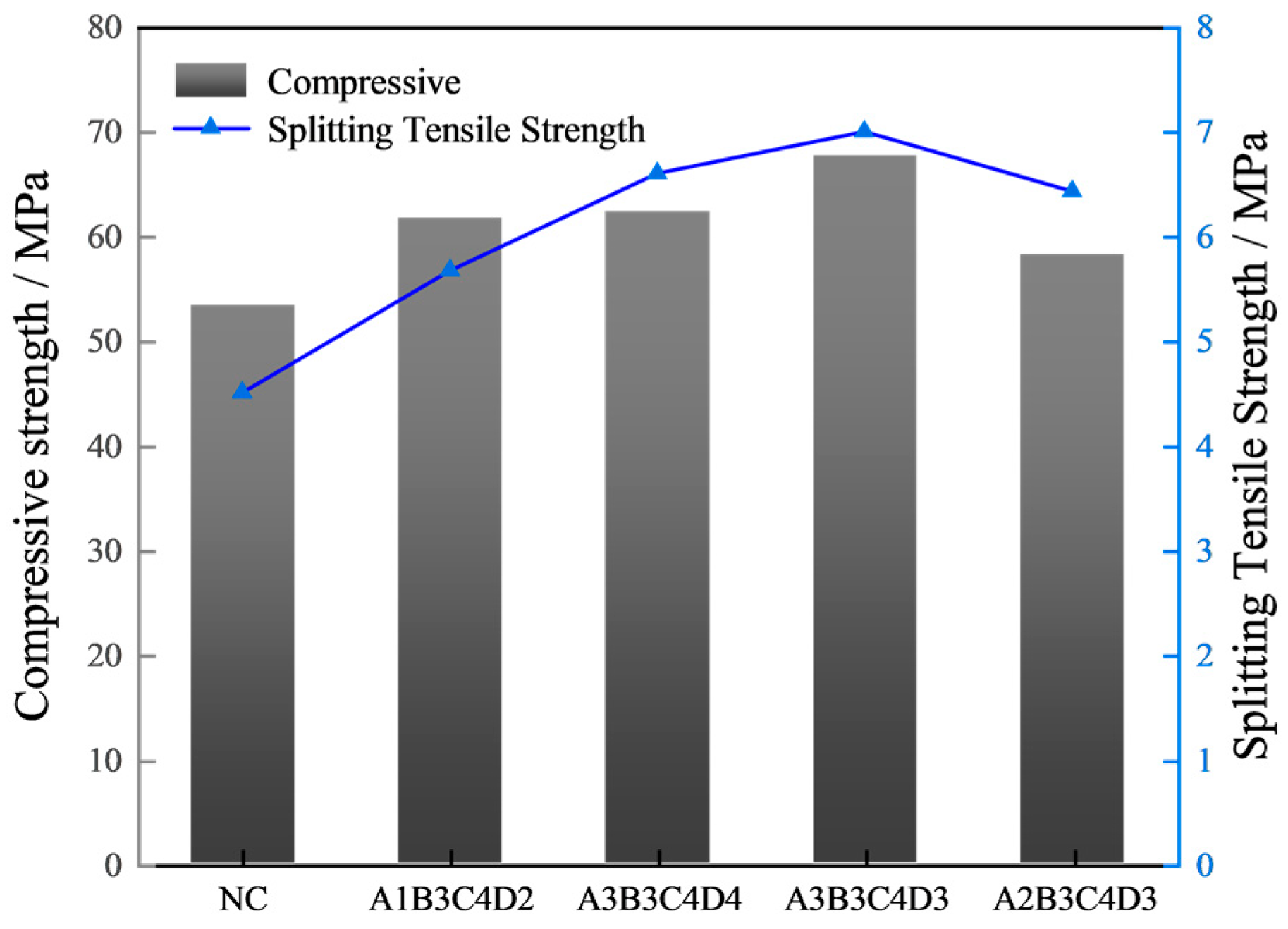



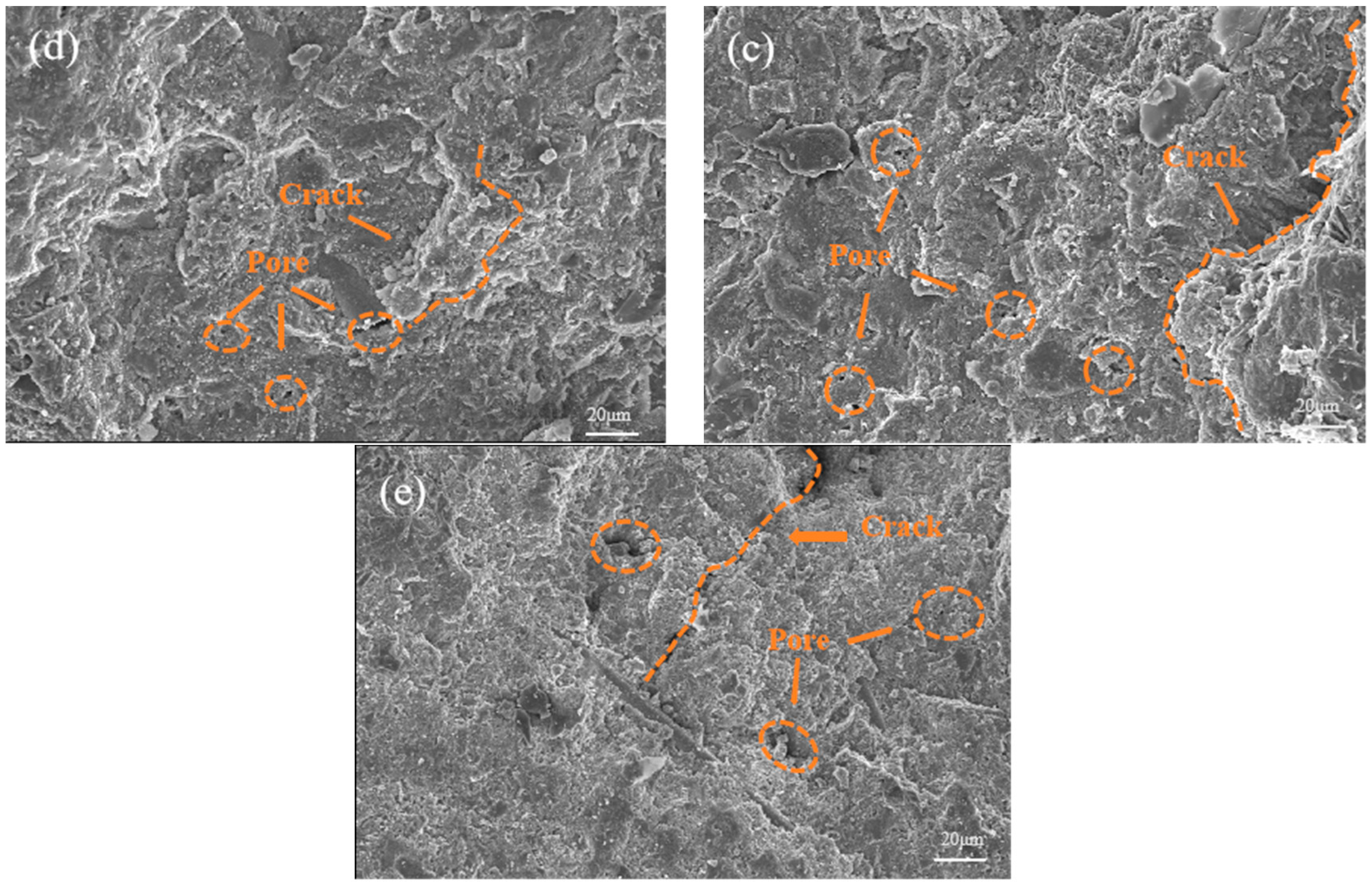


| Density/ g·cm−3 | Time/min | Flexural Strength/MPa | Compressive Strength/MPa | |||
|---|---|---|---|---|---|---|
| Initial Setting | Final Setting | 3d | 28d | 3d | 28d | |
| 3.1 | 178 | 228 | 6.4 | 9.2 | 30.6 | 57.3 |
| Grade | Fineness/% | Loss on Ignition/% | Water Demand Ratio/% | Moisture Content/% |
|---|---|---|---|---|
| I | 7.7 | 2.1 | 94 | 0.3 |
| SiO2/% | Loss on Ignition/% | Specific Surface Area/m2·g−1 | Cl−/% |
|---|---|---|---|
| 96.2 | 3.92 | 19.1 | 0.07 |
| Types | Length/mm | Diameter/μm | Density/g·cm−3 | Elongation/% | Tensile Strength/MPa | Elasticity Modulus/GPa |
|---|---|---|---|---|---|---|
| BF | 12–15 | 7–15 | 2.65 | 2.8 | 4000 | 105 |
| PF | 12 | 35.86 | 0.91 | 25 | 3700 | 35.86 |
| Level | FA/wt% | SF/wt% | BF/vol% | PF/vol% |
|---|---|---|---|---|
| A | B | C | D | |
| 1 | 0 | 0 | 0 | 0 |
| 2 | 10 | 5 | 0.05 | 0.05 |
| 3 | 15 | 10 | 0.1 | 0.1 |
| 4 | 20 | 15 | 0.2 | 0.2 |
| Number | Water | Cement | Coarse Aggregate | Sand | FA | SF | Water Reducer | BF | PF |
|---|---|---|---|---|---|---|---|---|---|
| 1 | 172 | 490 | 1128 | 610 | 0 | 0 | 8.33 | 0 | 0 |
| 2 | 172 | 449 | 1128 | 610 | 41 | 0 | 8.33 | 1.32 | 0.455 |
| 3 | 172 | 428.5 | 1128 | 610 | 61.5 | 0 | 8.33 | 2.65 | 0.91 |
| 4 | 172 | 408 | 1128 | 610 | 82 | 0 | 8.33 | 5.3 | 1.82 |
| 5 | 172 | 469.5 | 1128 | 610 | 0 | 20.5 | 8.33 | 1.32 | 0.91 |
| 6 | 172 | 416 | 1128 | 610 | 41 | 20.5 | 8.33 | 0 | 1.82 |
| 7 | 172 | 408 | 1128 | 610 | 61.5 | 20.5 | 8.33 | 5.3 | 0 |
| 8 | 172 | 388 | 1128 | 610 | 82 | 20.5 | 8.33 | 2.65 | 0.455 |
| 9 | 172 | 449 | 1128 | 610 | 0 | 41 | 8.33 | 2.65 | 1.82 |
| 10 | 172 | 408 | 1128 | 610 | 41 | 41 | 8.33 | 5.3 | 0.91 |
| 11 | 172 | 387 | 1128 | 610 | 61.5 | 41 | 8.33 | 0 | 0.455 |
| 12 | 172 | 367 | 1128 | 610 | 82 | 41 | 8.33 | 1.32 | 0 |
| 13 | 172 | 428.5 | 1128 | 610 | 0 | 61.5 | 8.33 | 5.3 | 0.455 |
| 14 | 172 | 388 | 1128 | 610 | 41 | 61.5 | 8.33 | 2.65 | 0 |
| 15 | 172 | 367 | 1128 | 610 | 61.5 | 61.5 | 8.33 | 1.32 | 1.82 |
| 16 | 172 | 346.5 | 1128 | 610 | 82 | 61.5 | 8.33 | 0 | 0.91 |
| Number | FA | SF | BF | PF | Compressive Strength/MPa | Splitting Tensile Strength/MPa | ||||
|---|---|---|---|---|---|---|---|---|---|---|
| 0d | 7d | 28d | 0d | 7d | 28d | |||||
| 1 | 1 | 1 | 1 | 1 | 32.00 | 35.85 | 52.38 | 2.78 | 3.10 | 4.5 |
| 2 | 2 | 1 | 2 | 2 | 31.20 | 36.83 | 53.12 | 2.70 | 3.17 | 4.598 |
| 3 | 3 | 1 | 3 | 3 | 30.50 | 48.80 | 56.12 | 2.50 | 3.77 | 5.885 |
| 4 | 4 | 1 | 4 | 4 | 28.50 | 44.90 | 53.34 | 2.10 | 3.00 | 5.72 |
| 5 | 1 | 2 | 2 | 3 | 34.50 | 42.70 | 52.26 | 3.10 | 3.60 | 4.94 |
| 6 | 2 | 2 | 1 | 4 | 33.17 | 45.40 | 54.08 | 3.27 | 3.90 | 5.1 |
| 7 | 3 | 2 | 4 | 1 | 33.20 | 56.50 | 62.71 | 3.65 | 4.12 | 6.57 |
| 8 | 4 | 2 | 3 | 2 | 33.87 | 45.83 | 51.70 | 3.10 | 4.05 | 5.57 |
| 9 | 1 | 3 | 3 | 4 | 42.03 | 55.30 | 66.03 | 3.90 | 4.10 | 5.472 |
| 10 | 2 | 3 | 4 | 3 | 37.50 | 56.70 | 68.08 | 3.67 | 4.67 | 6.77 |
| 11 | 3 | 3 | 1 | 2 | 36.13 | 52.00 | 58.67 | 2.96 | 3.45 | 4.848 |
| 12 | 4 | 3 | 2 | 1 | 36.87 | 45.30 | 55.69 | 2.80 | 3.80 | 5.1 |
| 13 | 1 | 4 | 4 | 2 | 38.90 | 56.03 | 61.48 | 3.50 | 4.30 | 6.93 |
| 14 | 2 | 4 | 3 | 1 | 37.20 | 51.10 | 54.00 | 3.15 | 3.80 | 4.53 |
| 15 | 3 | 4 | 2 | 4 | 36.70 | 53.85 | 60.38 | 2.70 | 4.10 | 5.3 |
| 16 | 4 | 4 | 1 | 3 | 34.60 | 45.70 | 56.00 | 2.93 | 3.60 | 4.67 |
| Level | 0d | 7d | 28d | ||||||||||
|---|---|---|---|---|---|---|---|---|---|---|---|---|---|
| A | B | C | D | A | B | C | D | A | B | C | D | ||
| K | 1 | 35.73 | 30.55 | 33.98 | 34.82 | 47.22 | 41.09 | 44.49 | 46.94 | 58.04 | 53.74 | 55.28 | 56.2 |
| 2 | 35.4 | 33.69 | 34.82 | 35.02 | 47.26 | 47.61 | 44.42 | 47.42 | 58.07 | 55.19 | 55.36 | 56.24 | |
| 3 | 34.13 | 37.63 | 34.77 | 34.91 | 52.79 | 52.33 | 50.26 | 48.47 | 59.47 | 62.87 | 56.96 | 58.87 | |
| 4 | 33.46 | 36.85 | 35.16 | 33.97 | 45.43 | 51.67 | 53.53 | 49.86 | 54.18 | 57.96 | 62.15 | 58.46 | |
| Optimum level | 1 | 3 | 4 | 2 | 3 | 3 | 4 | 4 | 3 | 3 | 4 | 3 | |
| R | 2.27 | 7.08 | 1.18 | 1.06 | 7.36 | 11.23 | 9.11 | 2.93 | 5.29 | 9.13 | 6.87 | 2.67 | |
| Compressive Strength | Factor | Degree of Freedom | Sum of Squares | Mean Square | F | p |
|---|---|---|---|---|---|---|
| 0d | A | 3 | 13.594 | 4.531 | 2.074 | 0.282 |
| B | 3 | 125.892 | 41.964 | 19.21 | 0.018 * | |
| C | 3 | 3.006 | 1.002 | 0.459 | 0.731 | |
| D | 3 | 2.789 | 0.93 | 0.426 | 0.749 | |
| Error | 3 | 6.553 | 2.184 | − | − | |
| 7d | A | 3 | 122.201 | 40.734 | 33.556 | 0.008 ** |
| B | 3 | 319.544 | 106.515 | 87.747 | 0.002 ** | |
| C | 3 | 242.949 | 80.983 | 66.714 | 0.003 ** | |
| D | 3 | 20.141 | 6.714 | 5.531 | 0.097 | |
| Error | 3 | 3.642 | 1.214 | − | − | |
| 28d | A | 3 | 70.017 | 23.339 | 0.949 | 0.485 |
| B | 3 | 107.607 | 35.869 | 1.459 | 0.178 | |
| C | 3 | 155.407 | 51.802 | 2.106 | 0.276 | |
| D | 3 | 29.396 | 9.799 | 0.398 | 0.759 | |
| Error | 3 | 73.779 | 24.593 | − | − |
| Factor | Level | 7d | 28d | ||||||
|---|---|---|---|---|---|---|---|---|---|
| A | B | C | D | A | B | C | D | ||
| K | 1 | 3.89 | 3.59 | 3.63 | 3.78 | 5.21 | 4.93 | 4.86 | 4.95 |
| 2 | 4.02 | 3.96 | 3.79 | 3.82 | 5.24 | 5.32 | 4.98 | 5.24 | |
| 3 | 3.97 | 4.06 | 4.04 | 4.17 | 5.43 | 5.55 | 5.36 | 5.65 | |
| 4 | 3.73 | 3.99 | 4.16 | 3.85 | 5.1 | 5.18 | 5.77 | 5.15 | |
| Optimum level | 2 | 3 | 4 | 3 | 3 | 3 | 4 | 3 | |
| R | 0.29 | 0.47 | 0.53 | 0.39 | 0.33 | 0.62 | 0.91 | 0.7 | |
| Splitting Tensile Strength | Factor | Degree of Freedom | Sum of Squares | Mean Square | F | p |
|---|---|---|---|---|---|---|
| 7d | A | 3 | 0.268 | 0.062 | 0.278 | 0.84 |
| B | 3 | 0.16 | 0.183 | 0.818 | 0.564 | |
| C | 3 | 8.452 | 0.228 | 1.02 | 0.494 | |
| D | 3 | 0.379 | 0.127 | 0.568 | 0.673 | |
| Error | 3 | 1.005 | 0.223 | − | − | |
| 28d | A | 3 | 0.222 | 0.089 | 0.267 | 0.847 |
| B | 3 | 0.805 | 0.053 | 0.16 | 0.917 | |
| C | 3 | 2.014 | 2.817 | 8.407 | 0.047 * | |
| D | 3 | 1.05 | 0.126 | 0.377 | 0.778 | |
| Error | 3 | 1.579 | 0.335 | − | − |
| Number | Minimum Pore Area/μm2 | Maximum Pore Area/μm2 | Porosity/% |
|---|---|---|---|
| NC | 0.47259 | 32.70 | 2.85 |
| A1B3C4D2 | 0.47259 | 13.96 | 2.25 |
| A2B3C4D3 | 0.47259 | 10.82 | 1.09 |
| A3B3C4D3 | 0.47259 | 7.84 | 0.71 |
| A3B3C4D4 | 0.47259 | 22.41 | 2.06 |
Disclaimer/Publisher’s Note: The statements, opinions and data contained in all publications are solely those of the individual author(s) and contributor(s) and not of MDPI and/or the editor(s). MDPI and/or the editor(s) disclaim responsibility for any injury to people or property resulting from any ideas, methods, instructions or products referred to in the content. |
© 2024 by the authors. Licensee MDPI, Basel, Switzerland. This article is an open access article distributed under the terms and conditions of the Creative Commons Attribution (CC BY) license (https://creativecommons.org/licenses/by/4.0/).
Share and Cite
Li, Z.; Li, G.; Wang, C.; Li, W.; Zheng, H. Optimization Design of Mix Proportion for Fly Ash–Silica Fume–Basalt Fiber–Polypropylene Fiber Concrete under Steam Curing Condition. Materials 2024, 17, 1971. https://doi.org/10.3390/ma17091971
Li Z, Li G, Wang C, Li W, Zheng H. Optimization Design of Mix Proportion for Fly Ash–Silica Fume–Basalt Fiber–Polypropylene Fiber Concrete under Steam Curing Condition. Materials. 2024; 17(9):1971. https://doi.org/10.3390/ma17091971
Chicago/Turabian StyleLi, Ziqian, Gang Li, Chong Wang, Wei Li, and Huaping Zheng. 2024. "Optimization Design of Mix Proportion for Fly Ash–Silica Fume–Basalt Fiber–Polypropylene Fiber Concrete under Steam Curing Condition" Materials 17, no. 9: 1971. https://doi.org/10.3390/ma17091971





